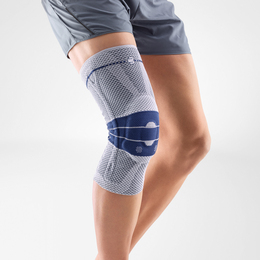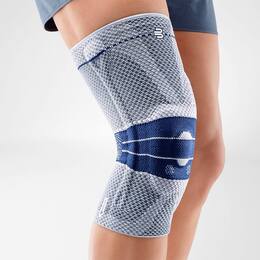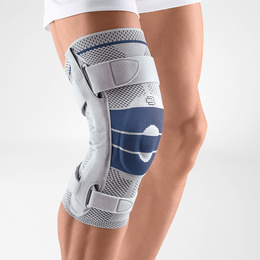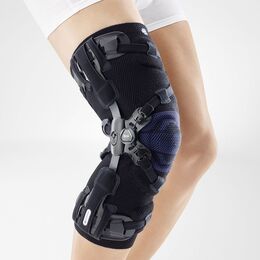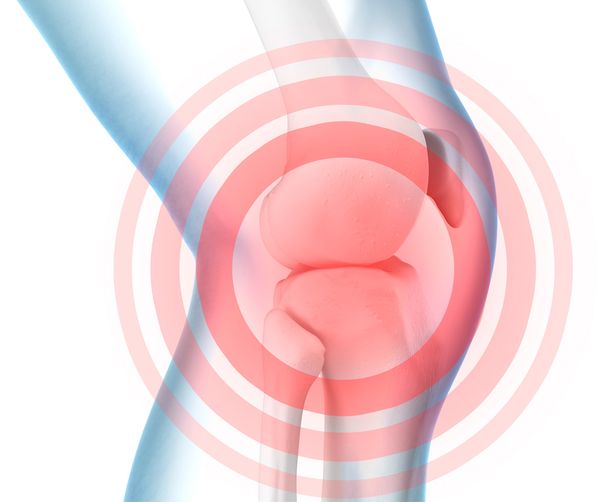Osteoarthritis – Causes and treatment options
Why is it that many people experience pain in their knees, especially after long periods marked by a lack of movement – for example after working in the office all day? Osteoarthritis, which is a joint disease, is one possible cause of such discomfort. This degenerative disease often develops as people get older, as excessive strain leads to wear on the cartilage in the knee joint over the years.
Initial movements after long periods of lying down or sitting then become painful, but this pain dissipates after a short time. As the disease progresses however, pain in the knees intensifies and begins to significantly restrict a person’s ability to move normally as they go about their daily activities.
Although osteoarthritis cannot be cured, there are various ways to treat it so that pain levels are reduced and the progression of the disease is slowed. Wearing a medical-grade compression knee brace or support, for example, relieves the strain on the knee and stabilizes it.
Causes of Osteoarthritis:
Healthy articular cartilage performs a buffering and protective function in the knee by cushioning it against movement and impacts. This cartilage ensures that the thigh and lower leg bones do not directly rub up against each other. It’s normal for cartilage to deteriorate through wear as part of the natural aging process. Under certain circumstances such wear on cartilage can become excessive. Overburdening of the knees brought about by heavy physical work, participating in competitive sports or being overweight are possible causes of this excessive wear on cartilage. Other causes include inappropriate mechanical stress due to incorrect movements when participating in sports, as well as joint misalignments such as knock knees or bandy legs.
Osteoarthritis can also develop as a result of joint injuries or bone fractures. In addition, individuals with gout suffer from deposits of uric acid crystals that collect in their joints, and if a knee joint is affected by this build-up, cartilage tissue will be damaged, which in turn could lead to Osteoarthritis.

Osteoarthritis – a disease that “creeps up” on you: Osteoarthritis often isn’t noticed for a long period of time because the illness doesn’t necessarily lead to pain in its early stages. Many of those afflicted with it therefore don’t even realize that they have a degenerative disease.
Initial indications and the different stages of osteoarthritis

An osteoarthritis condition can be completely pain-free – and therefore often remain unnoticed – for a relatively long time. In most cases, the first symptom of Osteoarthritis is pain in the knee – initially after a prolonged period of inactivity or rest. Initial movements after sitting or lying for a long time feel stiff and painful. Pain only begins to subside after a few minutes, or after taking a few steps. After that, the knee can be moved freely. In some cases, a crunching or cracking sound can be heard in the knee joint when it is moved.
As the disease progresses, the pain becomes steadily worse and more frequent. This knee pain becomes more intense particularly when knees are exposed to stress through sports or when climbing stairs. In a later stage of the disease, even slight movements can lead to pain that may even persist when the knees are at rest.
The ever-greater wear on cartilage increasingly restricts the mobility of the knee joint, ultimately causing it to stiffen up. At this point, the knee can no longer be bent as much – and later on it can no longer be stretched out completely.
If cartilage damage is severe enough that the bones begin to rub up against each other, it is possible that the joint can become inflamed. The knee joint will then swell up and the skin around it will take on a reddish color and feel warm or hot to the touch.
In the case of pronounced Osteoarthritis, the knee joint ultimately becomes unstable and can twist without warning, which causes severe pain to shoot through the joint. When such pain occurs, many people intuitively attempt to protect their knee by avoiding movement, but this is counterproductive because a lack of movement reduces the blood flow to the cartilage, which in turn increases the level of cartilage damage. In severe cases, the knee can become stiff.
When to go to the doctor: If you experience persistent or recurring knee pain, you should consult an expert who can then exclude the possibility of osteoarthritis, or initiate a suitable treatment in a timely manner.
Diagnosing Osteoarthritis
A physician should be consulted in the event of persistent or recurring knee pain. The physician may make a diagnosis of Osteoarthritis, or of another type of knee irritation such as arthritis or joint effusion. The right physician to consult in such situations is an orthopedic specialist, who will ask you in an initial consultation to describe your symptoms, when they began occurring, and any underlying conditions you may have. Previous knee injuries can also play a role in the development of knee problems. The second step involves a physical examination of the knee joint using various tests that allow the physician to evaluate the mobility and functionality of the joint. A reliable diagnosis is usually made by taking X-ray images of the areas affected by pain; in the event of osteoarthritis, the extensive wear on cartilage can be seen as a narrowing of the joint space. At the same time, less severe cartilage wear is difficult to discern in X-ray images. In such situations, physicians therefore generally conduct a computed tomography (CT) or magnetic resonance imaging (MRI) scan after the X-ray examination.
Treating Osteoarthritis

Cartilage damage cannot be reversed. This means that osteoarthritis unfortunately cannot be cured, which is why treatment focuses mainly on relieving pain and slowing down the progression of the disease.
A conservative treatment might involve a weight-loss program, a change in habits in order to reduce strain on the knees, the prescription of medication, a program of physiotherapy exercises, and the use of orthopedic products. Elastic knee supports relieve pressure on the joint, while heat treatments often alleviate pain. In addition, anti-inflammatory and pain medications are used to prevent inflammation and reduce pain levels. Certain types of sports, specific exercises, and physiotherapy methods improve mobility and strengthen muscles.
Surgery often becomes necessary if conservative treatments fail to produce the desired result. Procedures exist for building up secondary cartilage tissue in the knee. This can reduce discomfort – and in some cases eliminate pain altogether. However, the load-bearing capacity of the new cartilage is not as great as that of the old cartilage. Artificial joint replacement is also an option in the case of severe Osteoarthritis.
Osteoarthritis pain alleviation and pressure relief with supports
Medical braces and supports form an important component of non-surgical treatment options for osteoarthritis, and Bauerfeind offers a range of products to help.
When a patient suffers from arthritis, finding a knee brace that offers support and effective pain relief while also being comfortable to put on can be a challenge. According to extensive testing by independent researchers, the Bauerfeind GenuTrain knee support is proven to relieve OA pain and improve knee stability while its anatomical shape and donning aids make it easy and comfortable to wear.

The Bauerfeind GenuTrain® A3 knee support provides even greater stability and targeted massage to the inflamed area of the knee. This support is particularly effective in improving the mobility of individuals who suffer from typical osteoarthritis symptoms, and with reduced pressure along the edges is more suited for patients with sensitive circulation. The fabric is softer in the sensitive area at the back of the knee and there is a larger anatomically-shaped massage pad surrounding the knee cap to further reduce pain and inflammation.
If your healthcare provider says supports cannot provide the knee-joint pain relief and pressure reduction you need, a knee brace with rigid components such as SecuTec OA can be used as part of a conservative osteoarthritis treatment. This multifunctional orthosis is equipped with anatomically contoured pressure cushions (pads) and anti-shock technology to provide more fluid walking movement. Knee pain is thus reduced and osteoarthritis sufferers benefit from greater everyday mobility. Please contact your healthcare provider for more information on this product, which is available by prescription only.
Comparison Chart
Bauerfeind is known globally for world class quality, innovation and manufacturing of orthopedic braces that provide proven therapeutic benefits and are extremely comfortable to wear. With the new GenuTrain OA, Bauerfeind now offers a complete range of knee OA solutions covering the different stages of OA progression.
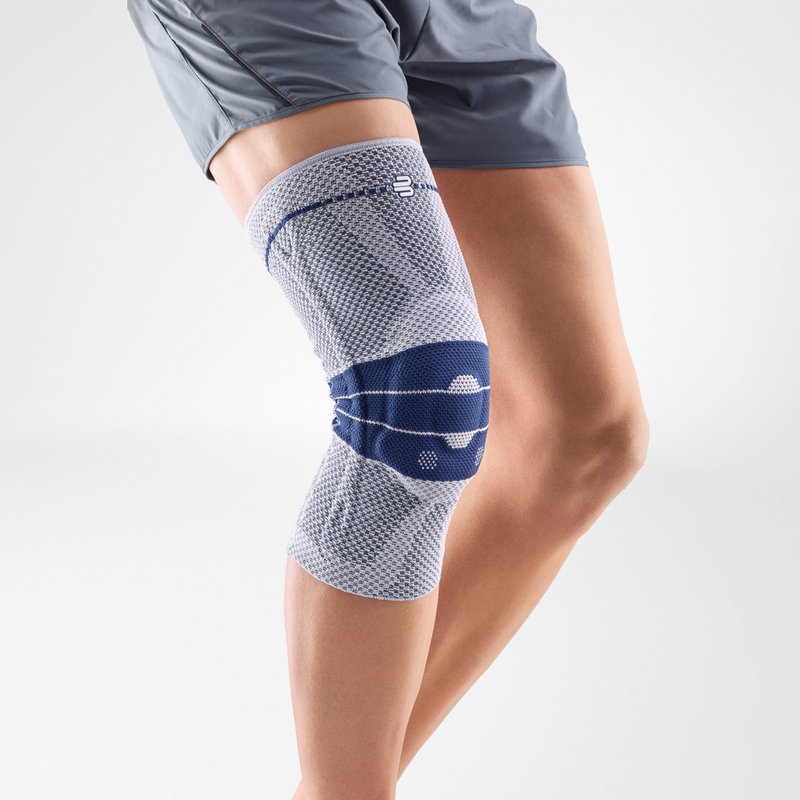 GenuTrain
GenuTrain
Best Seller!
|
 GenuTrain A3
GenuTrain A3
Mild to Moderate OA
|
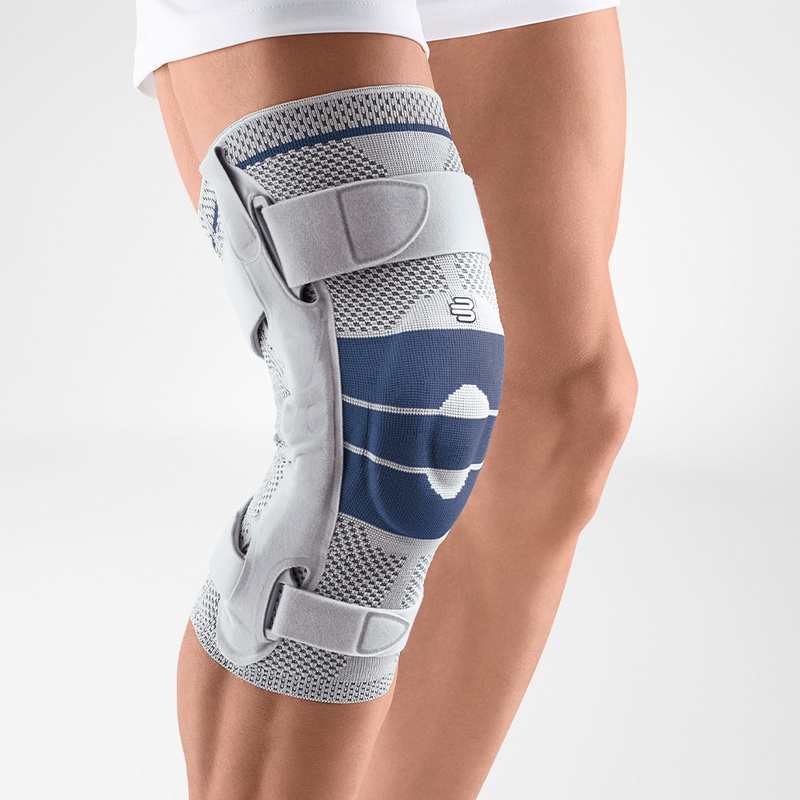 GenuTrain S
GenuTrain S
Advanced Stability
|
 GenuTrain OA
GenuTrain OA
NEW! Unloading Relief
|
|
| Medical-Grade Compression | ◉ | ◉ | ◉ | |
|---|---|---|---|---|
| Stimulates Proprioception | ◉ | ◉ | ◉ | ◉ |
| Hinged Brace with Stabilizing Sidebars | ◉ | ◉ | ||
| Pain / Strain / Instability / Swelling (Edema) | ◉ | ◉ | ◉ | ◉ |
| Tendinitis / Runner's Knee / Jumper's Knee | ◉ | ◉ | ||
| Mild - Moderate Osteoarthritis | ◉ | ◉ | ||
| Moderate - Severe Osteoarthritis (OA) | ◉ | ◉ | ||
| Meniscus Injury | ◉ | ◉ | ◉ | |
| Kneecap Dislocations / Patella Femoral Syndrome | ◉ | |||
| MCL / LCL Injuries (Grade I or II) | ◉ | ◉ | ||
| Shop now | Shop now | Shop now | Learn More |

